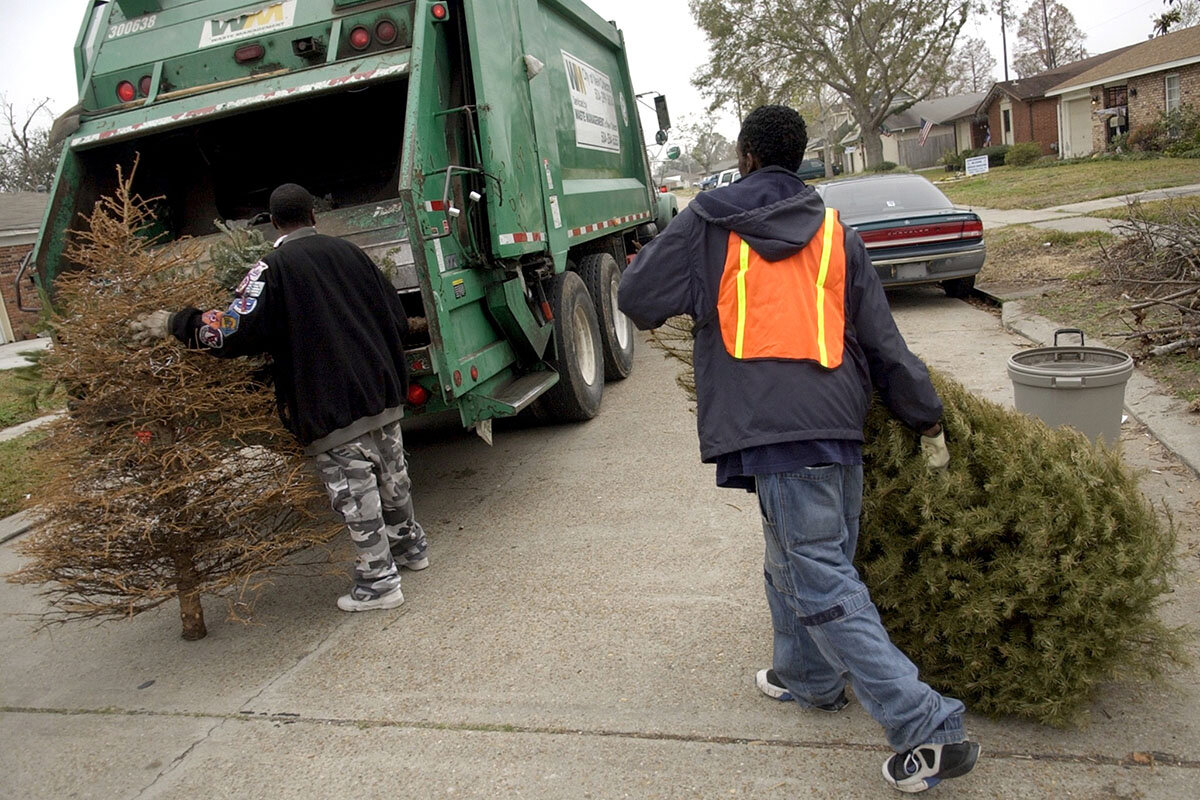Oh, Christmas tree: What happens to holiday waste after New Year’s?
Loading...
| New Orleans
The Christmas tree in your home was grown with a purpose. It was planted and nurtured until it had matured enough for sale. It was then cut down and hauled to town, where families scowled over it in search of the perfect sapling for this year’s holiday season celebration.
Then comes the decorating, the gifts beneath its boughs, and joyous moments near its gentle light.
But when the ornaments leave the branches, its purpose ends there. Like torn gift-wrapping paper, the tree then departs for the final leg of its journey, which in some cases is a landfill.
Why We Wrote This
A story focused onThe holidays generate more of it than any other season. A program in Louisiana uses discarded Christmas trees to help rebuild shorelines – symbolizing progress on a larger challenge of dealing more wisely with waste.
Louisiana takes a different path. For more than 20 years, the City of New Orleans, Louisiana National Guard, and the state’s Wildlife and Fisheries Department have partnered to extend the function of expired holiday trees by dumping thousands into coastal marshlands. Once there, the trees help bind the disappearing shore as they slowly decompose into sediment. Every little bit helps, coastal officials say. In nearly a century, Louisiana has lost roughly 2,000 square-miles of marshland as a result of human engineering and environmental degradation such as oil spills.
The most festive time of year – the winter holidays – is also the most consumptive. Americans generate about 25% more trash than usual between Thanksgiving and New Year’s Day. That considerable increase equates to about 25 million tons of additional waste during the holidays, according to estimates cited by Stanford University and the University of Colorado. That’s why efforts like the one here in Louisiana are important – mitigating a significant problem and perhaps engaging the public in positive ways.
“When I say it’s marginal, it’s in terms of the wetland functions we get out of it,” says John Nyman, a wetland wildlife ecologist at Louisiana State University, who’s observed the tree recycling program’s effects in recent years. “What turns out to be more important is the connection it allows people to have to our coast.”
Most waste still heads to landfills or incinerators
Even marginal steps toward waste reduction or more responsible disposal can make a difference, as more people follow them.
There are over 20,000 local governments across the U.S. Many are involved in their own means of creating paths for residents to recycle waste. (Some communities grind up old Christmas trees into mulch, for instance.) Through those local efforts, overall rates of recycling and reuse have risen to roughly 32% of the more than 292 million tons of U.S. municipal solid waste produced as of 2018. Half of all waste goes to landfills, and another 12% is burned for energy.
For companies like Hallmark, winter holidays are the peak sales season. The company estimates that more than 1.3 billion cards are sent annually in the weeks leading up to Christmas. Many of those then make their way into the trash bin. Often, that waste begins a journey into communities where its environmental effects will fall heaviest on poor residents and disproportionately on African Americans or other racial minorities. A study by the New School found that 80% of incinerators in the U.S. are located near low-income communities.
“What we purchase, how we act, and what we do has implications that are felt globally,” says Cody Marshall, chief optimization officer at the Recycling Partnership, a nonprofit dedicated to advancing the circular recycling economy. “I think we’re able to see that impact and how we help each other.”
Helping each other – in particular, coastal Louisianans – has been the basis of the state’s tree recycling program. The effort predates Hurricane Katrina in 2005, which exacerbated coastal erosion, as well as human-made catastrophes like the Deepwater Horizon oil spill in 2010.
It’s part of a larger sustainability push in New Orleans, a city that has been struggling with dysfunction in its waste collection.
New Orleans officials hope the tree recycling program helped set the tone for later efforts. They’re currently in the process of adding to their slate of sustainability goals, starting with a social media campaign to spread the word not to use artificial decorations like tinsel on trees.
It could harm our coast, says Cheryn Robles, New Orleans environmental affairs administrator. By contrast, she says the tree recycling project is tangibly helping. “You’ll see where the marsh has grown,” she says, referring to online photos of the results.
“People are driving the conversation”
Among the prior complexities that have hindered local recycling efforts is funding – a barometer that’s starting to shift when it comes to federal assistance.
In November, the Environmental Protection Agency announced $100 million in grants for recycling infrastructure, recycling education, and outreach projects across the nation. The grants are funded by the Biden administration’s Bipartisan Infrastructure Law’s investment of $375 million in waste prevention.
It represents the EPA’s largest investment in recycling infrastructure in roughly three decades.
“People are driving the conversation,” says Mr. Marshall. “It’s been fantastic to see, whether it’s how people are voting, how people are buying – it’s clear consumers want sustainable products.”
That desire can also be a connecting force.
Programs like tree recycling are “an annual reminder about our problem,” Professor Nyman says of the state’s disappearing coastline. “It’s an annual reminder there are things we can do to help out.”






